Quentin Tarantino
-
Pulp Fantastic: Geoffrey O’Brien on Quentin Tarantino’s Pulp Fiction
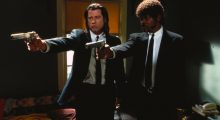
The cover of Filmmaker‘s seventh issue was Quentin Tarantino’s Pulp Fiction, considered here in this original essay by Geoffrey O’Brien that unpacks the film’s genre literature influences. In the lead-up to Tarantino’s Once Upon a Time in… Hollywood, it’s being posted online for the first time. — Editor The two dictionary definitions of “pulp” which Quentin Tarantino posts at the beginning of Pulp Fiction both have a direct bearing on what follows. The first, “a soft, moist, shapeless mass of matter,” recalling as it does the phrase “beat to a pulp,” invokes from the outset those catastrophes of the flesh […]
by Geoffrey O'Brien on Jun 8, 2019 -
Cannes 2019 Dispatch 6: Parasite, Once Upon a Time… in Hollywood, Mektoub, My Love: Intermezzo

A great prize list aside—better than any since at least 2011—I can’t fall in line with a majority of this year’s press corps in declaring this a banner year for Cannes; ironic, given that, on paper, this indeed was going to be a banner year for Cannes: Malick! Bonello! Hausner! Tarantino! Dumont! Diop! Lav! Bong! There was something for everyone, and most of it seemed to go down quite smoothly, even as distinctions between the good, bad, and ugly was as indiscernible as ever. On the two critics’ grids I participated in, for example, virtually every film across every section […]
by Blake Williams on May 25, 2019 -
Has Reservoir Dogs Aged Well?
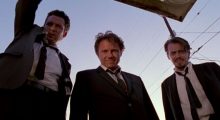
While its opening salvo, in which Quentin Tarantino’s legacy is rated against four other directors — three of whom are still fondly thought of here at Filmmaker — is a bit harsh, Evan Puschak’s video appreciation of Reservoir Dogs, QT’s first feature, digs into some of the aspects that make it a still-compelling watch a quarter of a century (!) later. And after you watch, check out Alex Rockwell’s interview with Tarantino upon the film’s release. (HT: Kottke.org)
by Scott Macaulay on May 5, 2017 -
Watch: Quentin Tarantino Had the Last Laugh
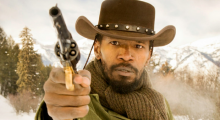
Laughter doesn’t immediately come to mind when you think of Quentin Tarantino’s body of work. But as video essayist Candice Drouet reveals in her latest video essay Tarantino Had The Last Laugh (above), Tarantino’s characters laugh more than you may recall….and the effect is quite menacing. The four-minute supercut features every instance a Quentin Tarantino character or the director himself laughs in one his films. The result is less hilarious than insidious as anyone familiar with the works referenced will understand the context of these laughs. More often than not, these characters are laughing at another character’s suffering or before or after they have inflicted suffering.
by Paula Bernstein on Jun 7, 2016 -
Watch: The First and Last Appearance of Quentin Tarantino Characters
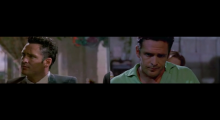
This one’s pretty self-explanatory: director Albert Gómez presents the first and last appearance of every major character in Quentin Tarantino’s movies in splitscreen. It does, of course, get bloody.
by Filmmaker Staff on May 26, 2016 -
Portland’s Historic Hollywood Theatre Caters to Cinephiles with 70mm
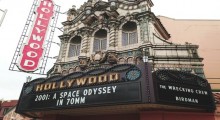
Within the course of one week in late December 2015, the historic Hollywood Theatre in Portland, Oregon made movie news twice. First, the non-profit theatre announced it would open The Hollywood Theatre @PDX, a new airport theatre which will highlight short films telling stories specific to Oregon and the Pacific Northwest. Then, none other than Quentin Tarantino showed up after a screening of The Hateful Eight (in 70mm, of course!) and took part in an impromptu Q&A. Both instances were indicative of The Hollywood Theatre’s efforts to court cinephiles with innovative programming, community outreach, and 70mm projection. As film audiences increasingly opt to stay home and […]
by Paula Bernstein on Apr 21, 2016 -
Watch: Quentin Tarantino’s Visual References
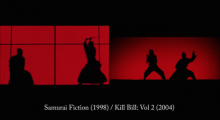
Jacob T. Swinney scratches the surface of Quentin Tarantino’s copious visual allusions/steals (depending on how you feel about his work) in this neatly split-screened video. Scenes, characters, costumes and even title cards all have their precedents.
by Filmmaker Staff on Jan 7, 2016 -
“Looking for False Performance Beats”: Editor Fred Raskin on The Hateful Eight
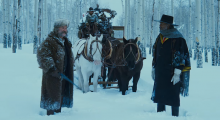
As the first film to be shot in the Ultra Panavision 70 format since Khartoum in 1966, Quentin Tarantino’s The Hateful Eight has deservedly garnered a lot of attention for its cinematography; shot in an extra-wide aspect ratio on a 65mm negative, it’s undeniably a spectacular showcase for director of photography Robert Richardson’s visual gifts. Subtler, but perhaps even more impressive, is the contribution of editor Fred Raskin, who assembles the 2.76:1 images like a maestro of space, timing, and movement. At over three hours in its Christmas Day “roadshow” edition, The Hateful Eight doesn’t have an extraneous frame – […]
by Jim Hemphill on Dec 28, 2015 -
Quentin Tarantino and Paul Thomas Anderson Talk 70mm on Christmas Eve
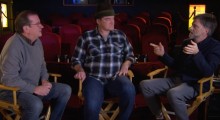
One of the nice things about a Weinstein Company Christmas Day release of a film by Quentin Tarantino (The Hateful Eight) is that the accompanying marketing material is necessarily cinephilic. Take this yuletide chat between Tarantino and Paul Thomas Anderson, shot in Tarantino’s home theater and moderated by Deadline’s Pete Hammond. Over forty minutes long, it deals with topics like the lifespan of the celluloid format (Tarantino says it has experienced “a reprieve”) as well why both he and Anderson like using the format for shooting films largely set in interiors. Check it out above.
by Scott Macaulay on Dec 25, 2015 -
Staggered: The Hateful Eight
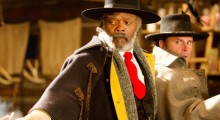
The following review contains spoilers. In Quentin Tarantino’s superbly balanced ensemble piece, The Hateful Eight, the passengers and drivers we meet at the start of the picture, dropped off at Minnie’s Haberdashy, a spacious Wyoming way station, by two different stagecoaches on different but overlapping missions, all have masked identities. Six years after the end of the Civil War, these are some of battle’s renegade residue, Confederate vets with few prospects who depend on bounty hunting to survive in a particularly testy postwar America. In the second coach there’s Chris Mannix (Walton Goggins, displaying the best of his high-energy talent), […]
by Howard Feinstein on Dec 24, 2015
